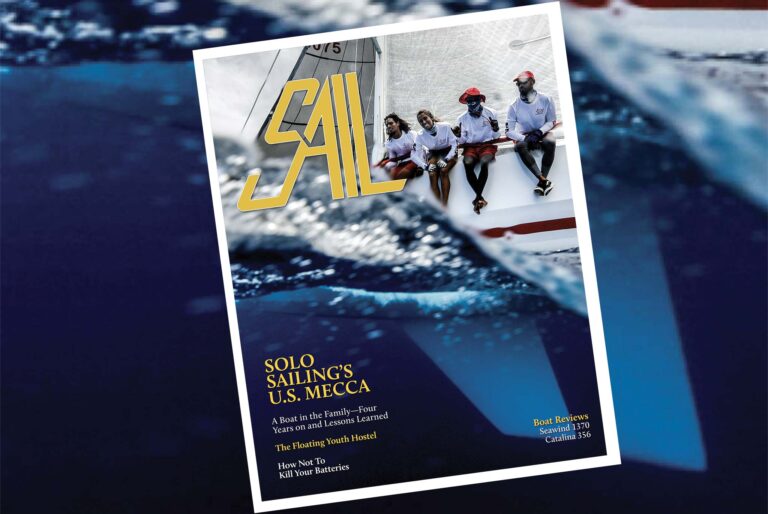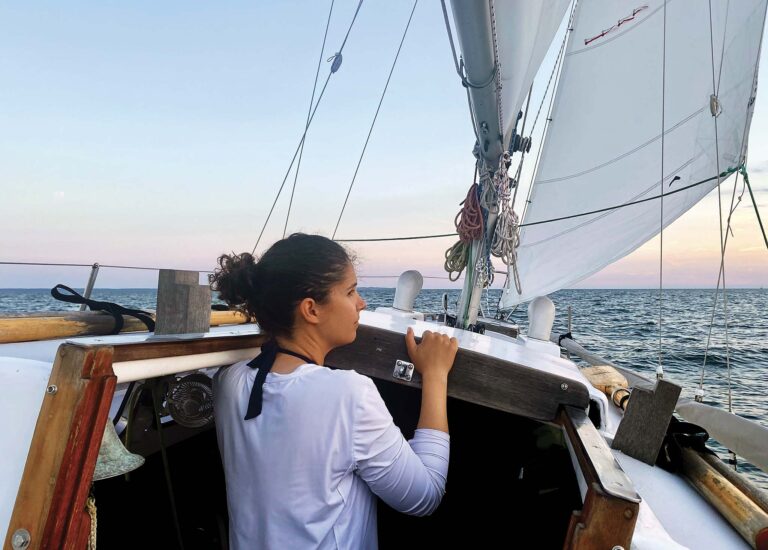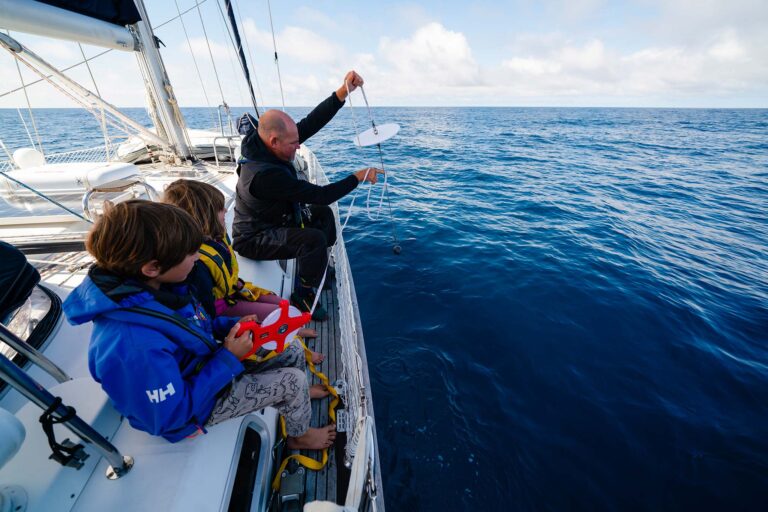
This column is usually about seamanship, a technical look at things to make us better sailors. But how does history play a part in that?
I was recently in Fort Lauderdale for a medical renewal of my captain’s license, and I stayed with Pam Wall, a young-at-heart old salt who’s become a close friend to Mia and me. Pam earned her sea miles long before there was GPS or much in the way of creature comforts onboard. We became fast friends after meeting in 2007 and have adopted her as our “Grandma Ocean” as she likes to say. Pam’s old school enough that she’s embarrassed to admit that last year she added an electric toilet to her beloved Freya 39, Kandarik. That sounds silly until you realize that the toilet on her first transatlantic adventure in the early ’70s was a bucket.
Importantly, though, Pam is still doing it. At 79, she’s fitter than ever, telling me how beneficial her recent gym routine is to her overall health and especially her balance on the boat. Pam still regularly sails Kandarik, which she and her late husband, Andy Wall, built with their own hands, on Biscayne Bay with her son, Jamie. Through her website pamwall.com, she regularly consults with cruising sailors about how to outfit their boats properly, and she’s been a guest on my sailing podcast “On the Wind” several times; indeed, the show’s title was coined in her living room in 2016.
Pam’s house is full of priceless sailing treasures and every one of them has a story. For example, in a guestbook that belonged to Andy’s first boat, Carronade, a 1965 entry from Auckland, New Zealand, shows the scrawled signature of one Ron Holland. He was 17 when he stepped aboard Carronade that day and signed the book, not yet the famous yacht designer he’d become.
Another entry from 1972 in England reveals the sharp, strong signature of one Chay Blyth from the yacht British Steel. Blyth is one of the first people to row across the Atlantic, an entrant in the first Golden Globe Race in 1968, and a contemporary of Sir Robin Knox-Johnston. His classic guestbook line is one only he could have written: “Fair winds & following seas + (booze & sex!).”
Many of Pam’s stories revolve around objects that are windows into entirely other lives and worlds she and Andy encountered as young sailors. Beside the kitchen counter is a beautiful scale model of a traditional whaleboat used in the Azores to hunt sperm whales. At the base of the model are four sperm whale teeth, all bigger than the palm of your hand, all artfully covered in spectacular scrimshaw.
“All of those teeth were given to us in Horta,” Pam recalls. “In 1972, when Andy and I were crossing the Atlantic on Carronade for our honeymoon, we stopped in Horta. Back then the locals were still hunting sperm whales, and it was a major part of their local economy.”
Pam told me that watch keepers on the cliffs around the harbor would fire guns when whales were spotted.
“One morning at 6 a.m., we heard the guns go off and a knock on the hull. They’d invited Andy along for the hunt.”
After a full day on the water in open sailing boats, they returned with a sperm whale. The boat that Andy was in had managed to kill one.
“It was a gruesome scene, but you’ve got to understand this was their way of life then. That whale we later found out was the only one they caught for the entire season.”
The steel harpoon tip used that day in 1972 occupies a spot on a bookshelf. And one of the teeth from the whale that Andy helped catch has a perfectly rendered scrimshaw image of Kandarik, sailing fast on a close reach with a reef in the mainsail. Pam and Andy had kept that unmarked tooth for 25 years, and when they returned to Horta on Kandarik in 1997, a local artist scrimshawed the image on it for posterity.
My favorite story of Pam’s involves another artifact, a small, nondescript belaying pin, maybe 10 inches long and made of bronze gone green with time.
“Andy found that pin on the wreck of Sterling Hayden’s schooner Wanderer in the South Pacific, en route to San Francisco,” Pam told me. Carronade had made port in Sausalito, and Andy and crew became fast friends with Spike Africa, Hayden’s first mate on Wanderer. They’d relayed the story of finding the pins.
“Well, one morning little Carronade, all of 30 feet long, listed to the weight of a large man stepping onboard the deck. Sterling Hayden introduced himself and not so much asked as demanded to have his belaying pins back!” Pam said. “Andy quickly collected five of them, but secretly kept one for himself and we’ve had it ever since. Of course, we went on to become dear friends with Sterling and his crew.”
Spending any amount of time with Pam in her house is going back in time. I was raised reading stories from the pioneers of cruising under sail, stories written in the ’60s and ’70s, and here is Pam who literally lived them. She was a contemporary to all the great sailing writers I grew up reading and idolizing. I was bowled over when she said, “We spent some wonderful time with Bernard Moitessier in the Pacific.” Moitessier?! The legend! People like him and Sterling Hayden are mystical figures to me, not “real” people, and yet they were friends with Pam.
But how important are these stories to our understanding of seamanship? Does it matter whether you know who Ron Holland or Chay Blyth or Sterling Hayden is? I’ll just assume you know who Moitessier is—he definitely matters.
For what it’s worth, I think it does matter. Pam and I spent an emotional hour discussing the balance between reflecting on the past versus planning for the future. You need both to be happy, we decided. Likewise, we as sailors should have an understanding of those who came before us as we continue to evolve, at the very least for a richer experience for ourselves on the water. These folks and the work they did are incredibly inspiring, and they can teach us something invaluable.
Pam and I love one of Moitessier’s early books, Cape Horn: The Logical Route. It’s his origin story, taking place before he became a sailing legend. In it, he describes recalling a passage from a book Vito Dumas wrote, Alone Through the Roaring Forties, where Dumas describes carrying sail and surfing the greybeards of the Southern Ocean during the worst weather. Moitessier’s Joshua was struggling in those same waters, towing warps and threatening to pitchpole. Dumas’ book was a lightning-strike moment for Moitessier—he cut the warps, Joshua came alive, and the Moitessier legend was born. (He’d later be credited in Adlard Coles’ Heavy Weather Sailing for inventing the “Moitessier Method” for severe heavy weather sailing…yet it wasn’t even his idea.)
There is always something to learn from the stories of the past, and that short trip to Pam’s was a real-life, stark reminder of that. Moitessier knew it, and it may have saved his boat and his life.
I went to Florida for a quick 15-minute physical, to get a piece of paper signed. I left with my head full of stories and my heart full of admiration, respect, and love.
August/September 2023










